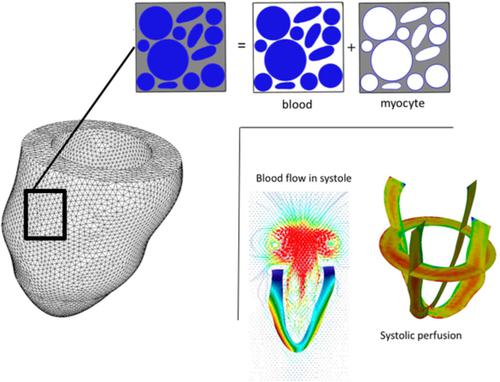当前位置:
X-MOL 学术
›
Int. J. Numer. Method. Biomed. Eng.
›
论文详情
Our official English website, www.x-mol.net, welcomes your
feedback! (Note: you will need to create a separate account there.)
A poroelastic immersed finite element framework for modelling cardiac perfusion and fluid–structure interaction
International Journal for Numerical Methods in Biomedical Engineering ( IF 2.2 ) Pub Date : 2021-02-08 , DOI: 10.1002/cnm.3446 Scott I Heath Richardson 1 , Hao Gao 1 , Jennifer Cox 2 , Rob Janiczek 2 , Boyce E Griffith 3 , Colin Berry 4 , Xiaoyu Luo 1
International Journal for Numerical Methods in Biomedical Engineering ( IF 2.2 ) Pub Date : 2021-02-08 , DOI: 10.1002/cnm.3446 Scott I Heath Richardson 1 , Hao Gao 1 , Jennifer Cox 2 , Rob Janiczek 2 , Boyce E Griffith 3 , Colin Berry 4 , Xiaoyu Luo 1
Affiliation

|
Modern approaches to modelling cardiac perfusion now commonly describe the myocardium using the framework of poroelasticity. Cardiac tissue can be described as a saturated porous medium composed of the pore fluid (blood) and the skeleton (myocytes and collagen scaffold). In previous studies fluid–structure interaction in the heart has been treated in a variety of ways, but in most cases, the myocardium is assumed to be a hyperelastic fibre‐reinforced material. Conversely, models that treat the myocardium as a poroelastic material typically neglect interactions between the myocardium and intracardiac blood flow. This work presents a poroelastic immersed finite element framework to model left ventricular dynamics in a three‐phase poroelastic system composed of the pore blood fluid, the skeleton, and the chamber fluid. We benchmark our approach by examining a pair of prototypical poroelastic formations using a simple cubic geometry considered in the prior work by Chapelle et al (2010). This cubic model also enables us to compare the differences between system behaviour when using isotropic and anisotropic material models for the skeleton. With this framework, we also simulate the poroelastic dynamics of a three‐dimensional left ventricle, in which the myocardium is described by the Holzapfel–Ogden law. Results obtained using the poroelastic model are compared to those of a corresponding hyperelastic model studied previously. We find that the poroelastic LV behaves differently from the hyperelastic LV model. For example, accounting for perfusion results in a smaller diastolic chamber volume, agreeing well with the well‐known wall‐stiffening effect under perfusion reported previously. Meanwhile differences in systolic function, such as fibre strain in the basal and middle ventricle, are found to be comparatively minor.
中文翻译:

用于模拟心脏灌注和流固耦合的多孔弹性浸入式有限元框架
现代心脏灌注建模方法现在通常使用多孔弹性框架来描述心肌。心脏组织可被描述为由孔隙液(血液)和骨骼(肌细胞和胶原支架)组成的饱和多孔介质。在之前的研究中,心脏中的流固耦合已经以多种方式进行了处理,但在大多数情况下,心肌被认为是一种超弹性纤维增强材料。相反,将心肌视为多孔弹性材料的模型通常会忽略心肌与心内血流之间的相互作用。这项工作提出了一个多孔弹性浸入式有限元框架,用于在由孔隙血液流体、骨架和腔室流体组成的三相多孔弹性系统中模拟左心室动力学。我们通过使用 Chapelle 等人 (2010) 之前的工作中考虑的简单立方几何形状检查一对原型多孔弹性地层来对我们的方法进行基准测试。该三次模型还使我们能够在对骨架使用各向同性和各向异性材料模型时比较系统行为之间的差异。使用这个框架,我们还模拟了三维左心室的多孔弹性动力学,其中心肌由 Holzapfel-Ogden 定律描述。将使用多孔弹性模型获得的结果与先前研究的相应超弹性模型的结果进行比较。我们发现多孔弹性 LV 的行为与超弹性 LV 模型不同。例如,考虑灌注会导致较小的舒张室容积,与之前报道的灌注下众所周知的壁硬化效应非常吻合。同时发现收缩功能的差异,例如基底和中心室的纤维应变,相对较小。
更新日期:2021-02-08
中文翻译:

用于模拟心脏灌注和流固耦合的多孔弹性浸入式有限元框架
现代心脏灌注建模方法现在通常使用多孔弹性框架来描述心肌。心脏组织可被描述为由孔隙液(血液)和骨骼(肌细胞和胶原支架)组成的饱和多孔介质。在之前的研究中,心脏中的流固耦合已经以多种方式进行了处理,但在大多数情况下,心肌被认为是一种超弹性纤维增强材料。相反,将心肌视为多孔弹性材料的模型通常会忽略心肌与心内血流之间的相互作用。这项工作提出了一个多孔弹性浸入式有限元框架,用于在由孔隙血液流体、骨架和腔室流体组成的三相多孔弹性系统中模拟左心室动力学。我们通过使用 Chapelle 等人 (2010) 之前的工作中考虑的简单立方几何形状检查一对原型多孔弹性地层来对我们的方法进行基准测试。该三次模型还使我们能够在对骨架使用各向同性和各向异性材料模型时比较系统行为之间的差异。使用这个框架,我们还模拟了三维左心室的多孔弹性动力学,其中心肌由 Holzapfel-Ogden 定律描述。将使用多孔弹性模型获得的结果与先前研究的相应超弹性模型的结果进行比较。我们发现多孔弹性 LV 的行为与超弹性 LV 模型不同。例如,考虑灌注会导致较小的舒张室容积,与之前报道的灌注下众所周知的壁硬化效应非常吻合。同时发现收缩功能的差异,例如基底和中心室的纤维应变,相对较小。











































 京公网安备 11010802027423号
京公网安备 11010802027423号